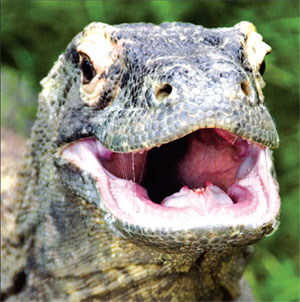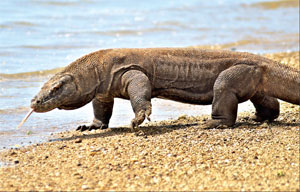|
Nature trail:
Three giant reptiles
Last week we took you on a journey into the world of reptiles and
promised to bring you some more interesting info about this group of
animals which has always brought mixed reactions from many people, not
only due to their unappealing appearance but also their harmful
behaviour, especially when it comes to species such as the snakes and
crocodiles.
The inhabitants of the reptile world are numerous ,so today let's
focus on three species that rank among the largest in this group.
Green anaconda

Komodo Dragon |
 |
A cousin of the reticulated python, South America's green anaconda is
a member of the boa family. Even though the reticulated python can reach
slightly greater length than it, many consider the green anaconda to be
the largest snake in the world. Why? Because of its enormous girth which
makes it almost twice as heavy. So, green anacondas are the largest (by
weight) snakes in the world. They are also among the longest snakes in
the world.
Green anacondas can grow to more than 29 feet (8.8 metres), weigh
more than 550 pounds (227 kilograms), and measure more than 12 inches
(30 centimetres) in diameter. And this is just the size of the male
anacondas. The females are said to grow even bigger. Green anacondas
are, as their name suggests, green in colour. They have black spots
across their entire bodies that are unsymmetrical, forming perfect
camouflage for the thick, dense forests that they live in. Spots on the
sides of their bodies often have yellow centres.
Like all reptiles, green anacondas have scaly skin. Their skin is dry
and somewhat thick. Green anacondas are very str ong and muscular, and
they must be so in order to attack and kill large prey.
The huge green anaconda is however not the only one found in South
America . There are other anaconda species, all smaller than the green
anaconda such as the yellow, dark-spotted, and Bolivian varieties.
Where would you come across this humongous creature in South America?
Generally in swamps, marshes, and slow-moving streams, mainly in the
tropical rain forests of the Amazon and Orinoco basins. Green anacondas
are very well adapted to living in the tropical rain forests of the
Amazon River Basin. Since they are cold-blooded, year-round
warm-temperatures help to keep their blood warm.
You may have seen them move about on land (on the electronic media or
in films )and observed how cumbersome they are on land. Don't be fooled
by it. They are stealthy and sleek in the water. As their eyes and nasal
openings are located on top of their heads, the anacondas can lie in
wait for prey while remaining nearly completely submerged in the water,
like the crocodiles.
If you are wondering as to what kind of diet they eat to become so
huge the answer is wild pigs, deer, birds, turtles, capybara, caimans,
and yes, hold your breath, even jaguars!
Anacondas are nonvenomous constrictors, coiling their muscular bodies
around captured prey and squeezing until the animal asphyxiates.(die or
lose consciousness due to impairing normal breathing). Anacondas have
jaws attached by stretchy ligaments which allow them to swallow their
prey whole, no matter the size. After eating a large animal anacondas
can wait weeks or months without food .
|

Green anacondas can grow to more than 29 feet. |
Anacondas are ovoviviparous, which means that the eggs hatch while
still inside the mother. Female anacondas retain their eggs and give
birth to two to three dozen live young. Baby snakes are about two feet
(0.6 metres) long when they are born and are almost immediately able to
swim and hunt. Their lifespan in the wild is about ten years. In 1997,
the movie "Anaconda" was made. The film features a giant green anaconda
that is being hunted by a snake hunter and a film crew. Watch the movie
and you will learn more about this slithering reptile.
Komodo dragon
The largest living species of lizard the Komodo dragon (Varanus
komodoensis), also known as the Komodo lizard is a member of the monitor
lizard family (Varanidae). It is found in the Indonesian Islands of
Komodo, Rinca, Flores, Gili Motang and Padar. Would you believe that
this lizard can grow to a maximum length of three metres (10 ft) in rare
cases and weigh up to around 70 kilograms (150 lb)? Their unusual
size has been attributed to island gigantism, since there are no other
carnivorous animals to fill the niche on the islands where they live. As
a result of their size, these lizards dominate the ecosystems in which
they live.
Komodo dragons were first recorded by Western scientists in 1910.The
Komodo dragon prefers to live in hot and dry places so they can be found
in dry open grassland, savanna, and tropical forest at low elevations.
It is most active in the day, although it exhibits some nocturnal
activity. Despite its visible ear holes the Komodo dragon does not have
an acute sense of hearing. It is only able to hear sounds between 400
and 2000 hertz. Its vision too is said to be poor at night even though
it can see as far away as 300 metres (980 ft). According to scientists
the Komodo dragon is able to see in colour, but as poor visual
discrimination of stationary objects.
As with many other reptiles the Komodo dragon too uses its tongue to
detect, taste, and smell stimul. It only has a few taste buds in the
back of its throat. Its scales, some of which are reinforced with bone,
have sensory plaques connected to nerves that facilitate its sense of
touch. The scales around the ears, lips, chin, and soles of the feet may
have three or more sensory plaques.Komodo dragons are generally solitary
animals and get together only for breeding and eating . They are
carnivores. The group behaviour of Komodo dragons in hunting is
exceptional in the reptile world. They hunt and ambush prey including
invertebrates, birds, and mammals. The diet of big Komodo dragons mainly
comprise deer, though they also eat considerable amounts of carrion.
There are reports of attacks on humans too from he area of West
Manggarai Regency where they live in Indonesia.
Komodo dragons have been observed knocking down large pigs and deer
with their strong tail. They are capable of running rapidly in brief
sprints up to 20 kilometres per hour (12 mph), diving up to 4.5 metres
(15 ft), and climbing trees proficiently when young through use of their
strong claws. For shelter, the Komodo dragon digs holes that can measure
from 1-3 metres (3-10 ft) wide with its powerful forelimbs and claws.
|

Leatherback Sea Turtle |
The female deposits about twenty eggs in abandoned megapode nests or
in a self-dug nesting hole in September. The eggs are incubated for
seven to eight months, hatching in April, when insects are most
plentiful. As young Komodo dragons are vulnerable to attacks from other
cannibalistic Komodo adults and predators they dwell in trees most of
the time . They take about eight to nine years to mature, and are
estimated to live for up to 30 years.
In the wild their range has contracted due to human activities and
they are listed as vulnerable by the IUCN. They are protected under
Indonesian law, and a national park, Komodo National Park, was founded
to aid protection efforts.
Leatherback sea turtle
The leatherbacks are said to be the largest turtles on Earth, growing
up to seven feet (two metres) long and exceeding 2,000 pounds (900
kilograms). Even though these turtles were once found in every ocean
except the Arctic and the Antarctic, today their population is rapidly
declining.
They rank as the most widely distributed reptile species and can be
found in the Pacific, Atlantic and Indian Oceans . Even in Sri Lanka
leatherback turtles can be seen in areas such as Induruwa, Kosgoda,
Mavela, Usangoda, Ambalantota, Bundala and Yala when they come to nest
on the beaches.
Leatherbacks undertake the longest migrations between breeding and
feeding areas of any sea turtle, averaging 3,700 miles (6,000 kilometres)
each way. Adult leatherbacks are known to travel as far north as Canada
and Norway and as far south as New Zealand and South America.
|

Leatherback baby turtle |
They are called reptilian relics by scientists because they are the
only remaining ones from a family of turtles that trace their
evolutionary roots back to over 100 million years. Most sea turtles have
hard, bony shells but the inky-blue shell of the leather backs are
somewhat flexible and almost rubbery to the touch. There are ridges
along the carapace which gives it a more hydrodynamic structure. Do you
know that leatherbacks can dive to depths of 4,200 feet (1,280 metres)-deeper
than any other turtle-and can stay down for up to 85 minutes?
Leatherbacks have the widest global distribution of all reptile
species, and possibly of any vertebrate. They can be found in the tropic
and temperate waters of the Atlantic, Pacific, and Indian Oceans
Leatherbacks have an edge over their reptilian relatives,when it comes
to maintaining body temperature.
They can retain warm body temperatures in cold water by using a
unique set of adaptations which include large body size, changes in
swimming activity and blood flow, and a thick layer of fat.Females come
ashore during the breeding season to nest. They excavate holes in the
sand to deposit around 80 eggs in the night. Once they fill up the nest
they return to the sea leaving a large, disturbed area of sand that
makes it difficult for predators to detect the nest .The eggs hatch out
either male or female baby turtles depending on the temperature inside
the nest. It is the temperature inside the nest that determines the
gender of the hatchlings, with higher temperatures producing females and
cooler temperatures producing males.
Most of the hatchlings do not make it to the sea because predators
which include humans kill or capture them . It is estimated that only
about one in a thousand leatherback hatchlings survive to adulthood.
Eggs are often taken by humans from nests to be consumed for subsistence
or as aphrodisiacs. The female hatchlings that do make it to the sea
often return to the same nesting areas as adults to produce their own
offspring. Males however never come back and spend the rest of their
lives roaming the seas.
Leatherbacks are currently designated as endangered under the U.S.
Endangered Species Act. The number of leatherbacks in the Atlantic
appears to be stable or increasing, but the Pacific population is
declining at an alarming rate due to egg harvest, fishery by catch,
coastal development, and highly variable food availability. Some Pacific
populations have disappeared entirely from certain areas, such as
Malaysia. Scientists around the world are tracking and studying
leatherbacks to learn more about these reptilian giants and how they can
be saved.
Pix and facts:
Internet. |



